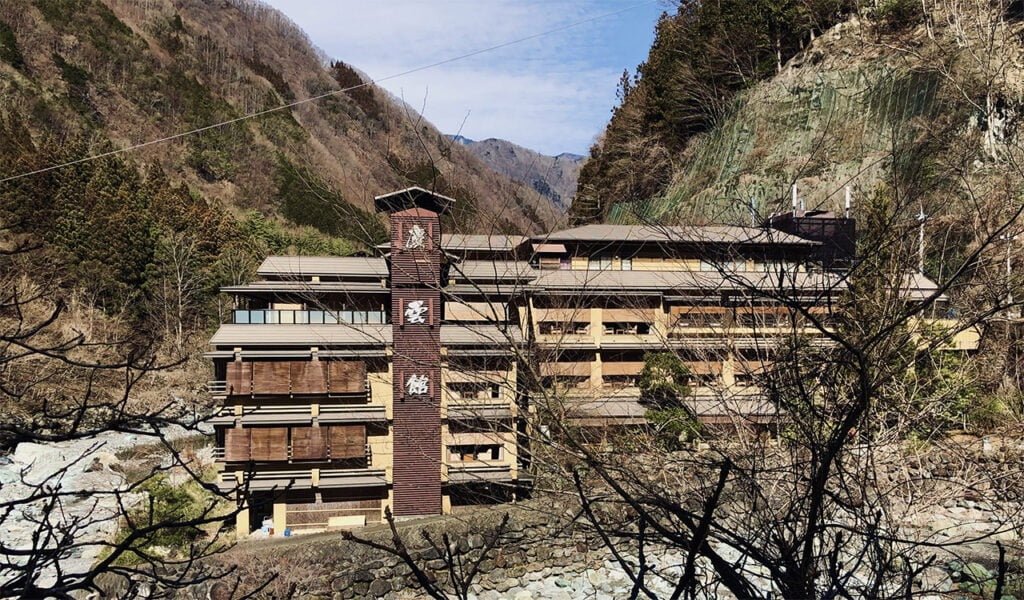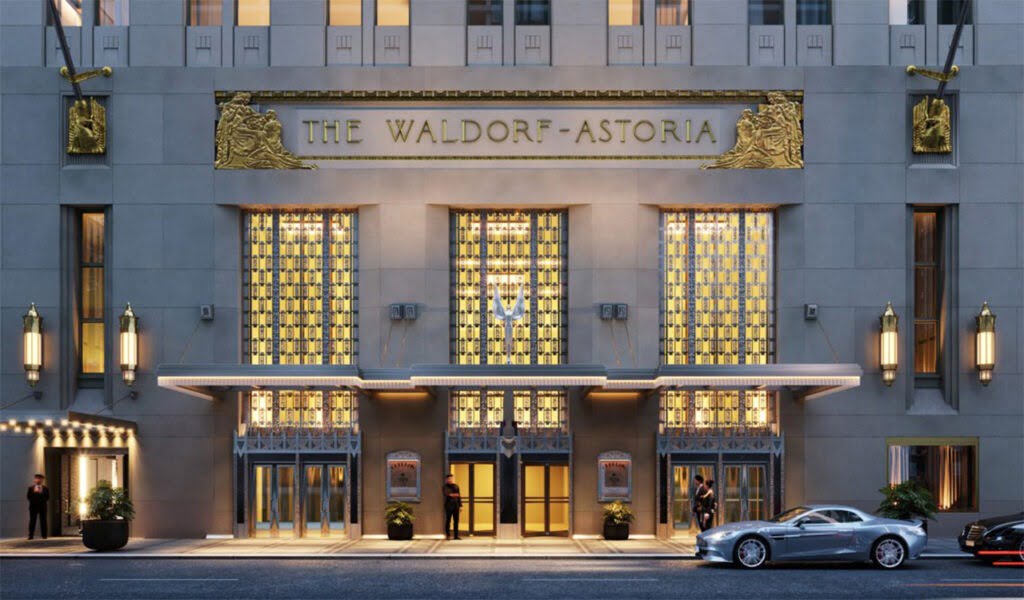Table of Contents
Introduction
The word hotel is derived from the French hotel, which refers to a French version of the townhouse. The term hotel was used for the first time by the fifth Duke of Devonshire to name a lodging property in London in AD 1760. The precursor to the modern hotel was the inn of medieval Europe. For a period of about 200 years from the mid-17th century, coaching inns served as a place for lodging for coach travellers. Inns catered to rich clients in the mid-18th century.
Many of us may argue that traveling is more about experiencing a city than it is about enjoying the hotel, but some would beg to differ. After all, a hotel, whether it’s a boutique architectural relic with only 20 guest rooms, or a sprawling space boasting over one resident restaurant, has much more to offer than simply a place to spend the night. There’s something refreshing and even grounding about living within walls that has been standing for centuries. Luckily, there’s no shortage of historic hotels across the world.
Examples of Historic Hotels
Hamilton Hotel, D.C, USA

Brief
Hamilton Hotel Washington, D.C., an iconic landmark in the heart of downtown D.C. with a modern approach to hospitality. Famed 14th Street, the Hamilton Hotel, a classic European structure with a distinctly American presence, has stood the test of time. Stood in 1851, the stately brick building served as a private school, but only a few years later, Admiral Horatio Bridge purchased the property and transformed it into a hotel dubbed Hamilton as a tribute to Mrs. Hamilton Holly, a family friend and the daughter of founding father Alexander Hamilton.
Design Process/Style
In 1921, the 70-year-old building was purchased by the Hamilton Hotel Corporation, a group of business people and bankers from Washington and New York. The group planned to demolish and build an 11-story, 300-room hotel, which was to be designed by celebrated architect Jules Henri de Sibour. Completed in 1922, the new Hamilton Hotel blended elements of the Beaux Arts and Art Deco styles, and featuring bas relief ornamentation of terracotta and stone.
With its triumphal arch and vaulted entry, grand lobby, marble floors, ornately designed interiors, and natural light in every room, the hotel offered a luxurious experience at a reasonable price, and it quickly became a hub of social life and commerce. Over the ensuing decades—as Hamilton Hotel underwent several major renovations, in keeping with the demands of a modern hotel—it has hosted everyone from musicians and entertainers to labour leaders and presidents.
Nishiyama Onsen Keiunkan, Japan
Brief
The one of the oldest historic hotels in the world, Nishiyama Onsen Keiunkan opened in 705 AD and has been passed down through the same family for an astounding 52 generations. But its historic pedigree isn’t the only reason to visit, with a mountaintop location in the town of Hayakawa and hot springs that pump out thousands of litres of hot mineral water a day into the hotel’s private hot spring baths (onsen), it’s a super relaxing setting. And you’ll be walking in the footsteps of all the legendary samurai and shogun that once stayed here, seeking the healing waters to soothe their weary, post-battle muscles.
Design Process/Style
The hotel has 37 rooms, a kaiseki restaurant, and a moon-viewing platform. The hotel underwent a major renovation in 1997 but preserved the traditional architectural style of the original onsen. During the stay at the hot springs at the base of Kyoto’s mountains, you can enjoy the same caliber of legendary hospitality experienced by noble samurai, famed shogun, and tourists for more than a thousand years. The hotel restaurant offers unique Miyama Kaiseki meals, seafood from Sanga, and some of the best Koshu beef in the entire world.
Kennebunkport Inn, USA
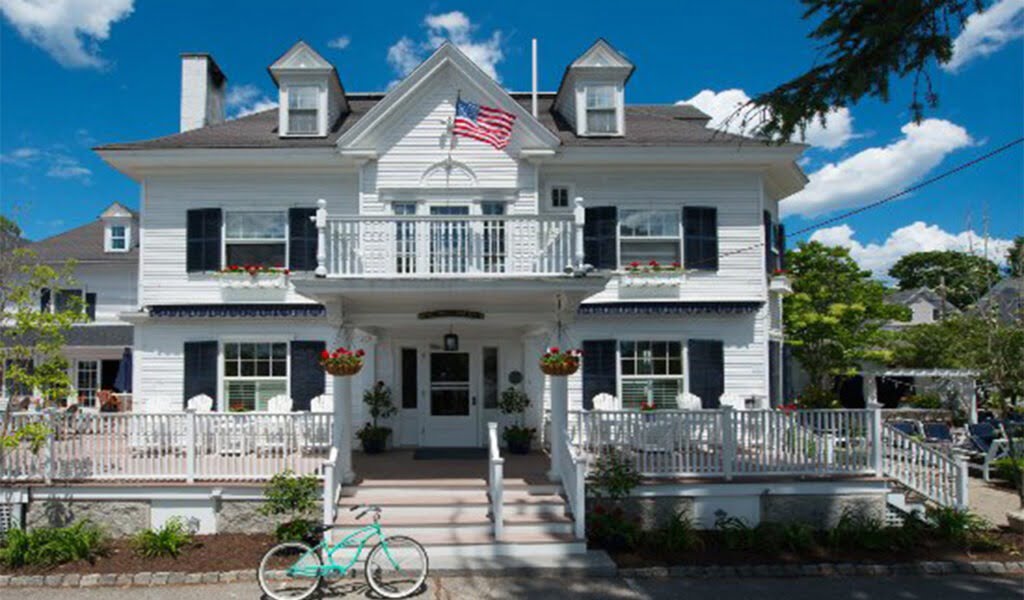
Brief
Built in the late 1890s, the Inn was once a tea merchant’s mansion. Design updates have respected the historic architecture while adding contemporary flair to its timeless appeal. Whether staying in the main house or in the River house, guests will delight in the understated luxury of their hotel room in every season. From a 35-room former mansion in Kennebunkport, Maine, to the iconic 19th-century Ritz Paris, the storied lodgings on offer are palpable.
Design Process/Style
There’s a completely different escape for spending a few days in some of the world’s longest-established hotels. The inn, which sits on four acres along 400 feet of frontage on the Kennebunk River, still boasts quite a few of the former Federal-style home’s original elements, including four open fireplaces, a parlour, a library, a butler’s pantry, and a servants’ dining room. And by 1961, Kennebunkport Inn had 10 guest rooms in the main building and 26 in the annex, which was constructed in the mid-20th century for locals and travellers alike.
The Stafford, London, UK
Brief
Tucked away in the heart of historic St James’s, and just minutes from London’s iconic landmarks and vibrant West End, The Stafford London is one of the finest luxury hotels in the Capital. Constructed solely as private residences on St. James’s Place in the 17th century, the several structures that make up what is now The Stafford London have changed hands quite a few times. It was formerly Richmond Club Chambers, Green’s Private Hotel, and St. James’s Palace Hotel.
Design Process/Style
The Stafford opened its doors to guests who can book a room or suite in any of the hotel’s three charming buildings: the main house, the mews house, and carriage houses, where the English nobility’s thoroughbreds lived. Though the hotel has been around for quite a lot—two world wars, the Titanic’s demise, and the longest-reigning monarch’s coronation.
The Stafford London’s guest rooms and suites are a masterclass in charismatic contemporary design with jewel-toned tufted quilts, geometric-inspired wallpaper, and unique patterns at play in nearly every nook and cranny. During World War II, The Stafford London served as a club for American and Canadian officers stationed overseas who sought refuge in the Wine Cellars. Originally built as stables to house the thoroughbreds of the nobility, The Carriage House was transformed to luxury accommodation in the late 1990s.
Rambagh Palace, Rajasthan, India

Brief
The Rambagh Palace in Jaipur, Rajasthan, is the former residence of the Maharaja of Jaipur located 5 miles outside the walls of the city of Jaipur on Bhawani Singh Road. Now a hotel, this 47-acre complex in the centre of Jaipur keeps all the regal grandeur of its previous incarnation. Staying in suites that have hosted the likes of Prince Charles and Jackie Kennedy, guests can take afternoon tea with Champagne on the veranda, play croquet amid peacocks and sip sundowner cocktails in the stately gardens.
Design Process/Style
Today, this jewel in the Taj’s crown offers 78 stunningly restored grand luxury rooms and suites in Jaipur, which were the chambers of the former Maharaja. The palace keeps its elaborate splendour, extravagantly decorated with hand-carved marble ‘jalis’ or latticework, sandstone balustrades, cupolas and ‘chattris’ or cenotaphs, and elaborate Mughal Gardens.
Within this most glorious of palaces showcasing the best of Rajasthan’s royal heritage, you also experience the best fine-dining restaurants in Jaipur. With the exquisite palace offering a scenic backdrop, our enormous selection of indoor and outdoor venues, along with the Sawai Man Mahal ideal for royal destination weddings and business events in Jaipur.
Copacabana Palace, Brazil
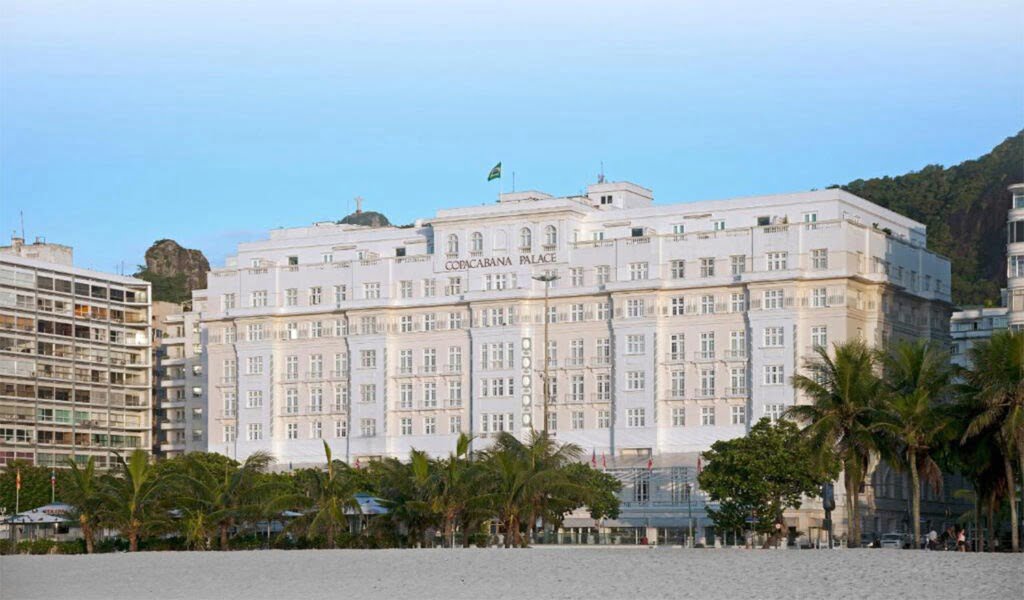
Brief
This Art Deco palace is a Rio de Janeiro landmark and was erected right on the edge of Copacabana Beach in 1923. Designed by French architect, Joseph Gire, the facade fuses Latin and European styles, partially resembling the extravagant mansions of the Cote d’Azur. It was immortalised in the 1933 film Flying Down to Rio, starring Fred Astaire and Ginger Rogers, and has attracted guests over the years including Albert Einstein, Nelson Mandela, Marilyn Monroe and Princess Diana. More recently, the Rolling Stones gave an impromptu, free concert on the beach while staying at the hotel in 2006.
Design Process/Style
The hotel was only inaugurated on August 13, 1923, almost a year after the Centennial Exposition. This was because of the difficulties in the importation of marbles and crystals and in the execution of its foundations to the lack of technology and experience in the country for such manufacturing. But for over 40 years, they have followed the pioneering spirit and passion for authenticity to create and uncover some of the world’s greatest travel adventures. On today’s date, their collection includes one-of-a-kind hotels, trains, river cruises and safari lodges in stunning destinations across the globe.
Waldorf Astoria, New York, USA
Brief
The Waldorf Astoria, New York is a luxury hotel in Midtown Manhattan in New York City. The structure is a 47-story- 625 ft Art Deco landmark designed by architects Schultze and Weaver, which was completed in 1931. The building was the world’s tallest hotel from 1931 until 1963. The Waldorf Astoria and Towers has 1,413 hotel rooms as of 2014. In 2009, when it had 1,416 rooms, the main hotel had 1,235 single and double rooms and 208 mini suites, while the Waldorf Towers, from the 28th floor up to the 42nd, had 181 rooms, of which 115 were suites, with one to four bedrooms.
Design Process/Style
Such is the architectural and cultural heritage of the hotel those tours are conducted of the hotel for guests in the main foyer is a chandelier measuring 10 feet by 10 feet. The elevator is furnished with panelled pollard oak and Carpathian elm. The grand clock, a 4000-lb bronze, was built by the Goldsmith’s Company of London originally for the 1893 World Columbia Exposition in Chicago, but was purchased by the Waldorf owners. The original Peacock Alley had been a 300-ft-long corridor lined with amber marble between the original two hotel buildings. Gilded, women of the times would enjoy walking along with it and admiring themselves in the mirrors.
Lygon Arms, London, UK
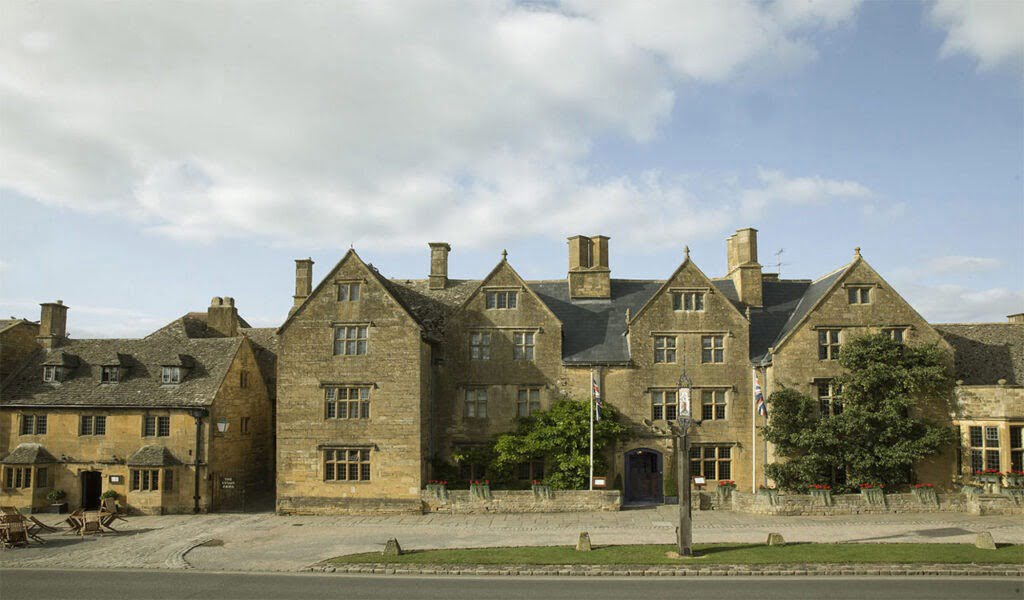
Brief
Set in the heart of the Cotswolds, a UNESCO World Heritage Site, the structure that makes up The Lygon Arms is so antiquated that its exact history is more or less unknown. However, documentary evidence from 1377 shows that a coaching inn stood on this site long before the current Tudor building. Further evidence of a medieval past is suggested by its then name: ‘The White Hart’, since the hart–a stag – was the personal symbol of King Richard II (1367-1400).
Design Process/Style
And in 1620, a man named John Trevis, perhaps the building’s then owner, stonemason, or maybe a local benefactor who sought to preserve his legacy long beyond his death, carved his name into the wall in the structure’s entry. Today, however, its deed rests in the capable hands of Iconic Luxury Hotels, who’ve honoured the former inn’s 650-year history in more ways than one. With charming guest rooms and suites spread across the main house, annex, courtyard, and cottage, there’s hardly a shortage of places to spend the night.
Jared Coffin House, Massachusetts, USA

Brief
Built in 1845 as his family’s residence by Jared Coffin, one of Nantucket’s wealthiest shipowners during the heyday of the whaling industry, the classic New England mansion now serves as a boutique hotel on the island’s powdery sand shores. Though much of the original structure has been expertly maintained, it’s had a bit of work done over the years: in 1857, the new owner, Eben W. Allen, constructed 3-story addition housing 16 bedrooms, and in 1961, the Nantucket Historical Trust completely renovated the estate and reopened it as the Jared Coffin House.
Design Process/Style
With 48 rooms spread across two buildings, including the original residence and a neighbouring one, the Daniel Webster house, there is definitely plenty of space to spread out. As one of the oldest hotels in Nantucket, Jared Coffin House embodies the essence of this former whaling town, offering charming accommodations combined with a host of modern-day comforts.
Riggs, Washington D.C, USA
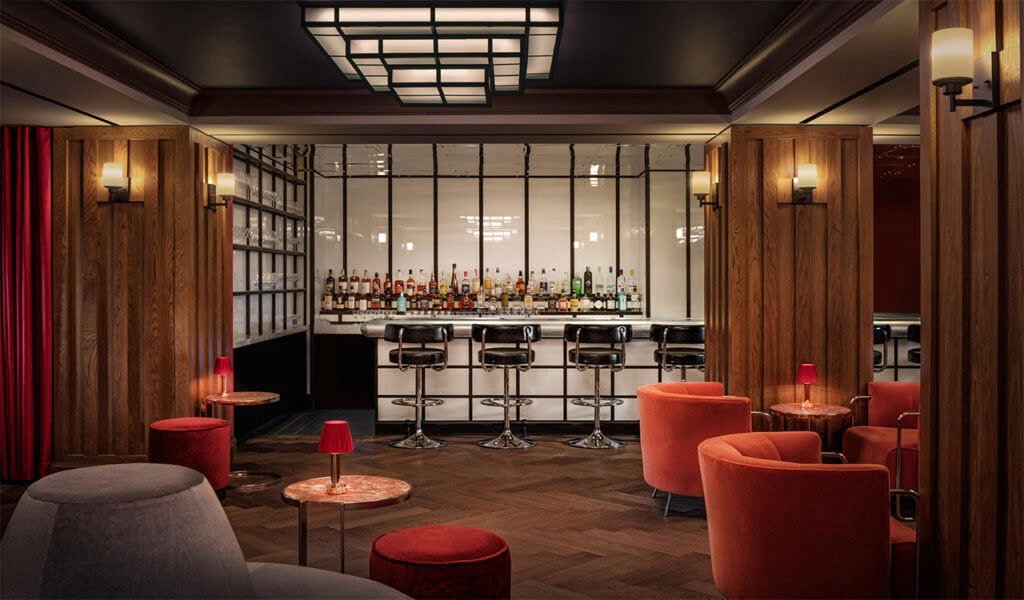
Brief
Riggs Washington, DC, was built in 1891 as the new Riggs Bank building completed in the Richardsonian Romanesque style. The bank described itself as “the most important bank in the most important city in the world”. Following a complete refurbishment, led by Lore Group Creative Director Jacu Strauss – Riggs has been reinvented as a luxury destination for modern travellers. Strauss was inspired by the building’s history and by the golden age of banking during his refurbishment.
Design Process/Style
Though the heart of many hotels is typically the guest rooms, that of the Riggs Washington D.C., within the former Riggs National Bank building, is the resident restaurant, Café Riggs. The ground-floor restaurant offers a masterclass in interior design by citrus-hued velvet swivel chairs, ornately carved coffered ceilings, and dramatic green marble floors so dark that, upon first glance, they almost look black. Of course, the private safe deposit box–inspired stay rooms, which follow the hotel’s Richardsonian Romanesque lead, hardly offer guests a reason to leave their rooms.
The Historic Anchorage Hotel, Alaska, USA

Historic Hotels Brief
In the heart of downtown Anchorage, The Historic Anchorage Hotel is listed on the National Register of Historic Places and is the only historic hotel in the city. Anchorage was in its infancy when the original Anchorage Hotel structure, on the corner of 3rd Avenue and E Street, was built. By 1936, the city of Anchorage was growing so rapidly that expansion was required.
Design Process/Style
The current building, the Anchorage Hotel Annex, was built across the alleyway and a sky bridge was constructed, connecting the two buildings. For many years, The Anchorage Hotel served as the city’s primary meeting and gathering place, and at one time, it was the only place in the new city where you could enjoy a meal served on fine China with linen and silver. Curtains rumbling, shower curtains swaying, pictures flying—it’s all par for the course at The Historic Anchorage Hotel. Stories of ghostly happenings have been circulating at the hotel for many years, and are considered being related to the death of Anchorage’s first Chief of Police.
Palmer House, Chicago, USA
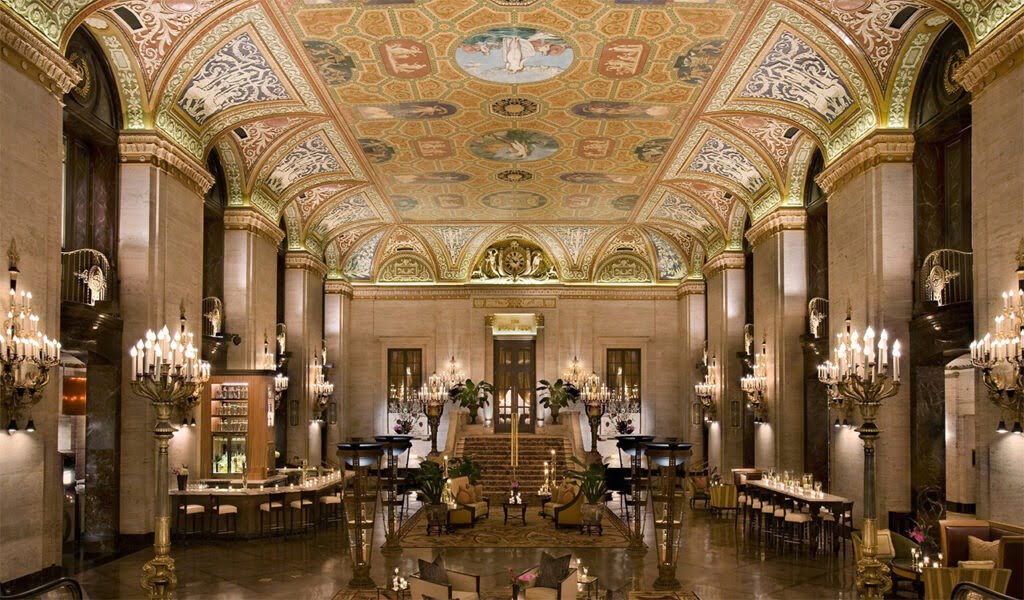
Brief
The story of downtown Chicago’s Palmer House Hilton is one of romance and undeniable charm. The country’s oldest continuously operating hotel got off to a rocky start. Thirteen days after its initial opening, it fell prey to the Great Chicago Fire. The resilient property rebounded and became a popular performance venue for the likes of Ella Fitzgerald, Louis Armstrong, and Liberace. Oh yeah, the brownie was invented here, too.
Design Process/Style
On November 8, 1873, the new Palmer House welcomed its first guests, marking the opening of what would become the nation’s longest continually operating hotel. Bertha Palmer began decorating the Palmer House with paintings and other pieces inspired by her French heritage. She eventually accumulated the largest collection of impressionist art outside of France. The Palmer House was bedecked with garnet-draped chandeliers, Louis Comfort Tiffany masterpieces, and a breath-taking ceiling fresco by French painter Louis Pierre Rigal.
In recent years at the historic Chicago hotel, Palmer House has undergone a $170 million renovation to ensure that it includes all the conveniences and comforts 21st-century guests expect while also preserving our significant history.


